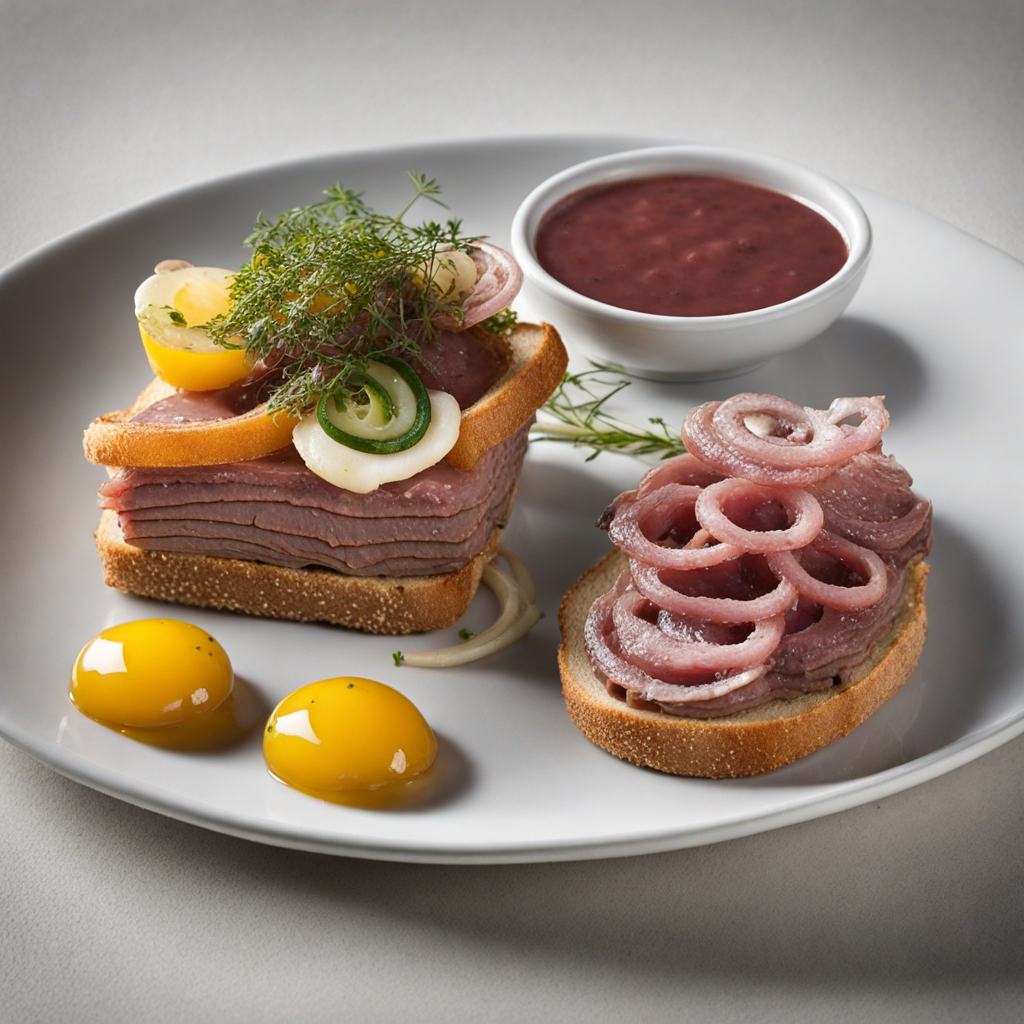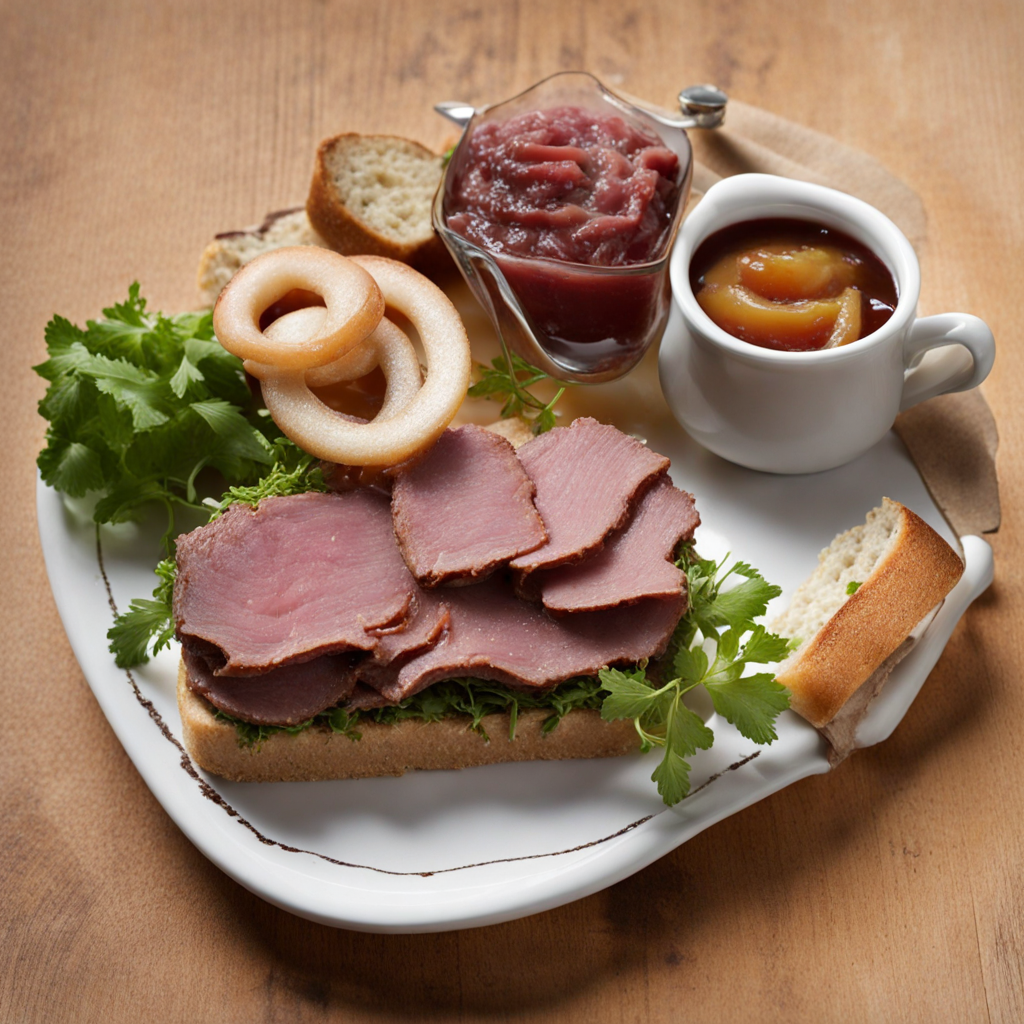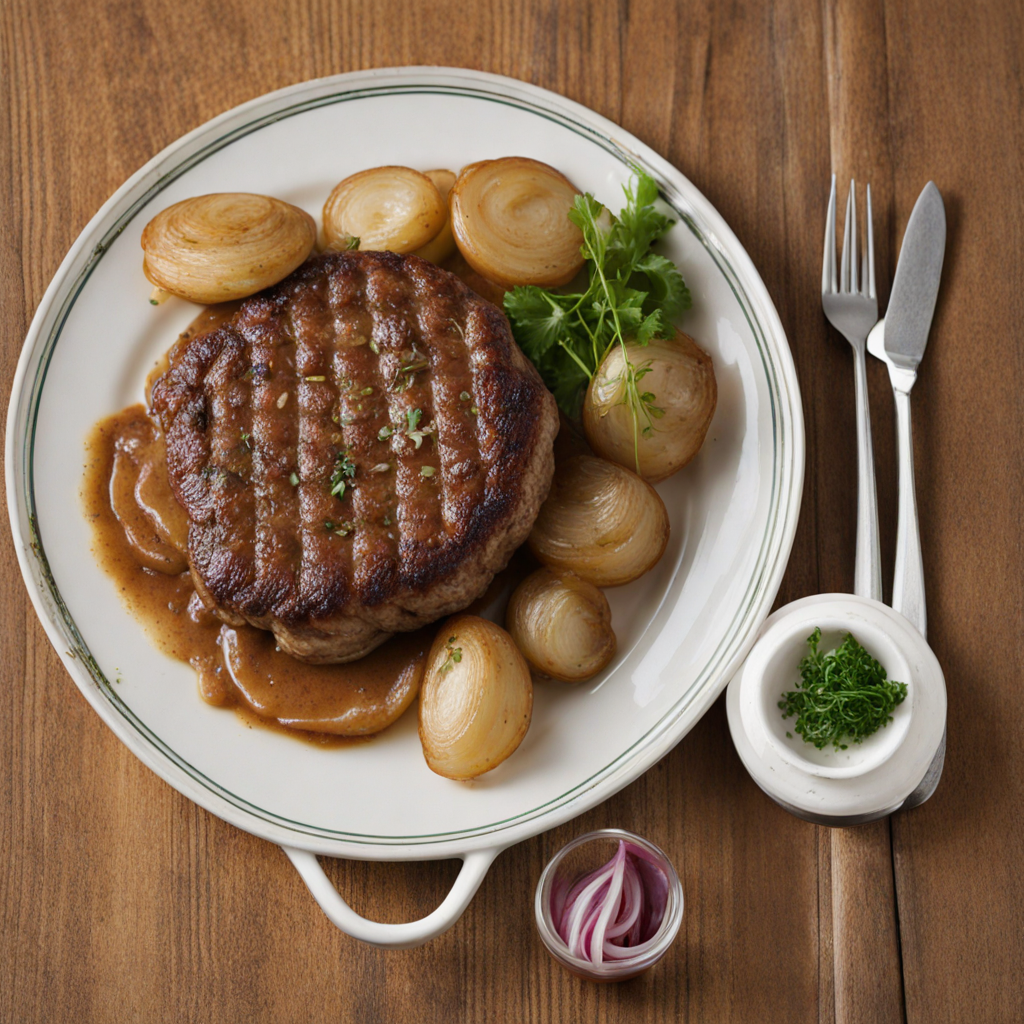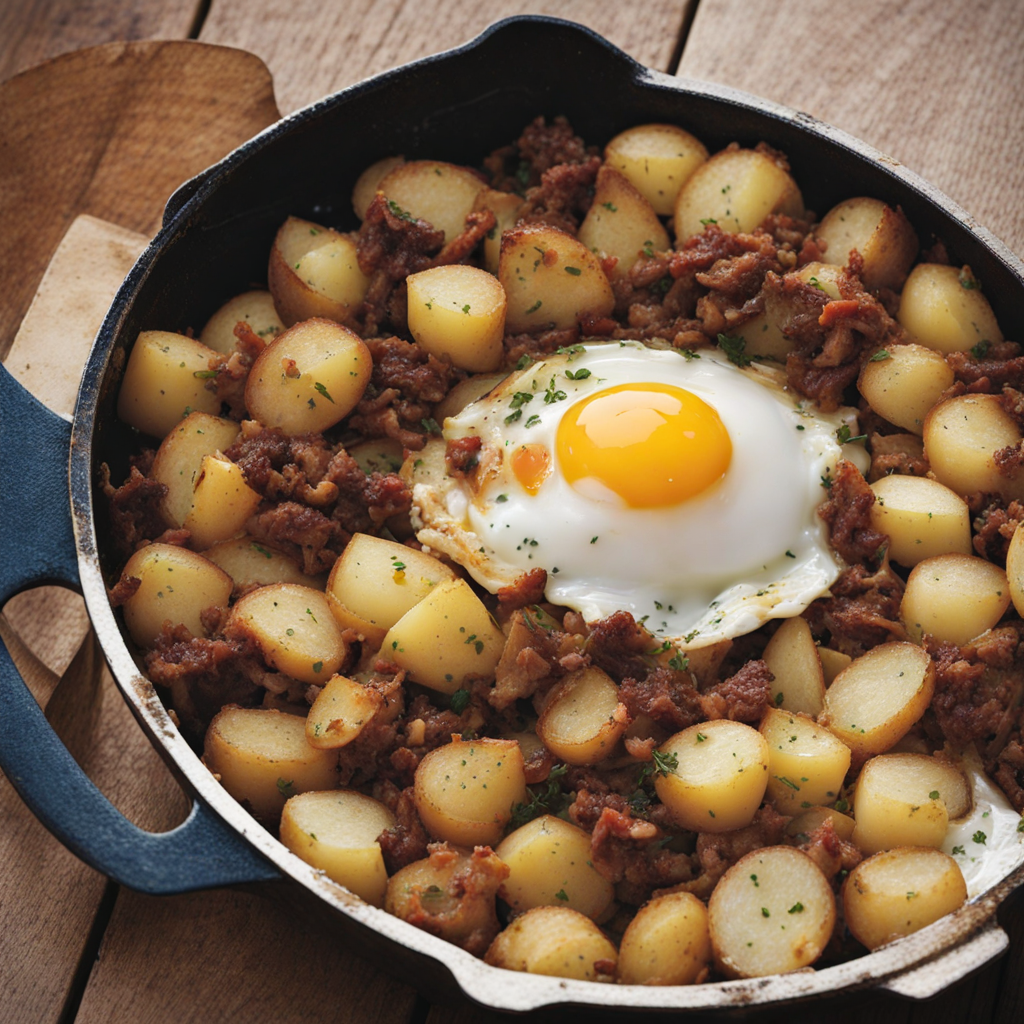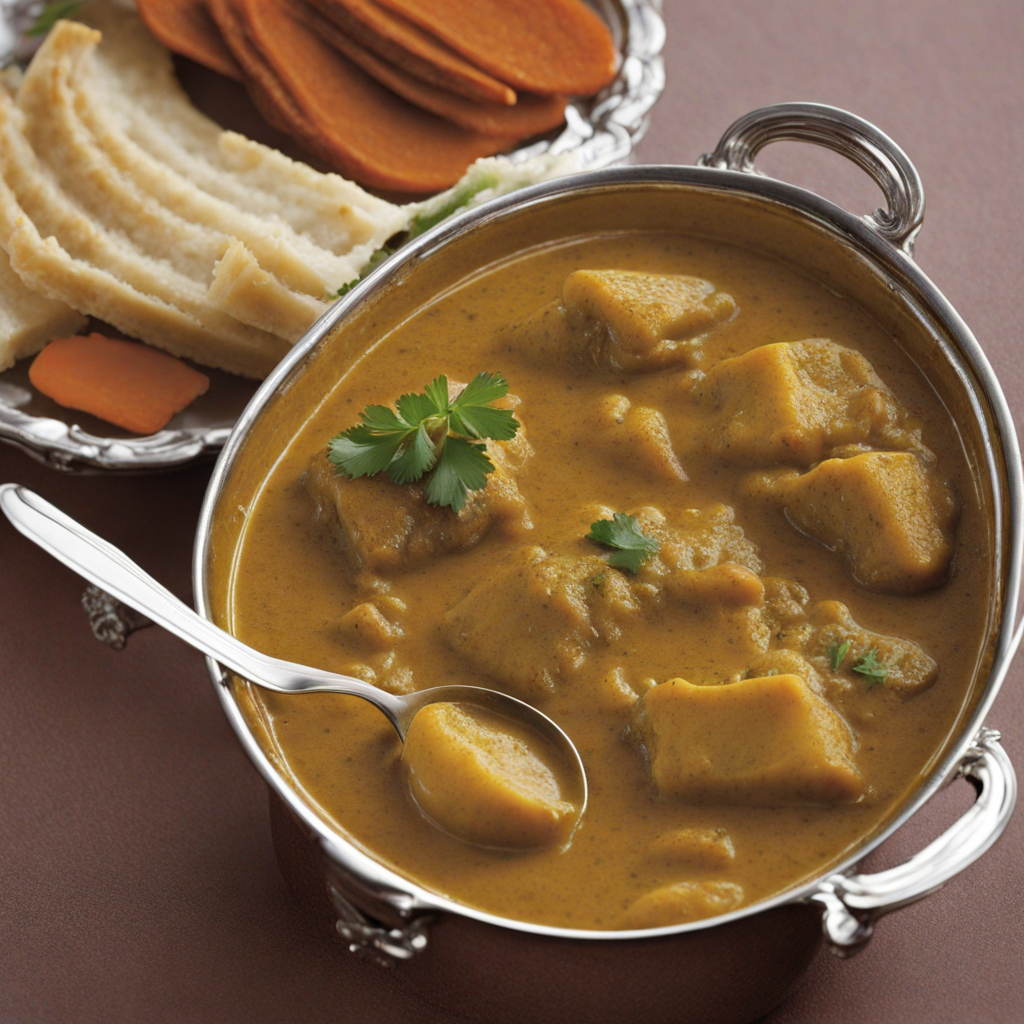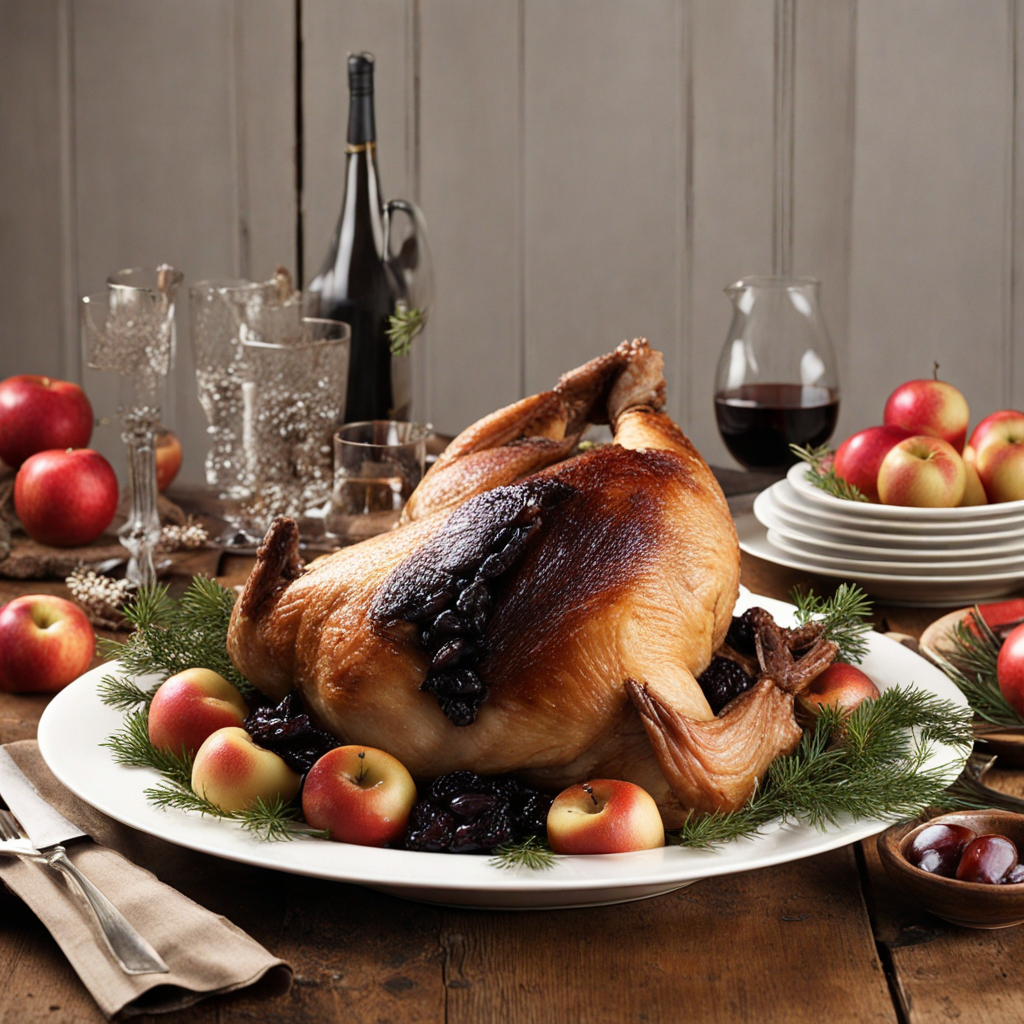Dyrlægens Natmad
Dyrlægens Natmad is a delightful Danish open-faced sandwich that offers a unique blend of flavors and textures, making it a perfect choice for adventurous eaters. The name translates to "The Doctor's Night Food," and it is traditionally enjoyed late at night, often after a night out. The foundation of this dish typically consists of a slice of dark rye bread, which provides a hearty and nutty base that complements the toppings beautifully. This type of bread is a staple in Danish cuisine, known for its dense texture and rich flavor, setting the stage for the other ingredients to shine. The toppings on Dyrlægens Natmad are what truly elevate this dish. A classic preparation includes a generous layer of liver pâté, which is smooth and rich, providing a creamy mouthfeel that contrasts with the crunch of pickled onions or crispy fried onions often added on top. The sandwich is then garnished with slices of tart pickles or beetroot, which add a refreshing acidity and vibrant color, balancing the richness of the pâté. Some variations may also include a slice of roasted meat, such as roast beef or pork, which brings additional depth and savory notes to the dish. To enhance the tasting experience, Dyrlægens Natmad is commonly finished with a sprinkle of fresh herbs, such as chives or dill, that add an aromatic quality. The combination of flavors—creamy, savory, tangy, and earthy—creates a symphony on the palate that is both satisfying and intriguing. Often enjoyed with a side of beer or aquavit, this traditional Danish treat is perfect for those looking to explore the comforting yet bold tastes of Denmark’s culinary heritage.
How It Became This Dish
Dyrlægens Natmad: A Culinary Tradition from Denmark When exploring the rich tapestry of Danish cuisine, few dishes encapsulate the nation's culinary heritage as vividly as *Dyrlægens Natmad*, or "The Doctor's Midnight Snack." This traditional Danish open-faced sandwich is not merely a meal; it is a reflection of Denmark's evolving social customs, its love for gourmet simplicity, and its unique way of weaving food into cultural identity. #### Origins: A Taste of the Past The origins of Dyrlægens Natmad can be traced back to the late 19th and early 20th centuries in Denmark. The term "Dyrlægen" translates to "the veterinarian," a nod to the profession that became associated with the dish. The story goes that this midnight snack was commonly enjoyed by veterinarians who worked long hours, often treating sick animals late into the night. As they finished their rounds, they would stop by local taverns or homes where they would be served hearty sandwiches to replenish their energy. The sandwich typically consists of rye bread (a staple in Danish cuisine), topped with an array of ingredients that often include liver pâté, pickles, raw onions, and a slice of cold cuts, such as roast beef or pork. The final touch is a generous dollop of mustard or a rich sauce, which adds depth and complexity to the flavor profile. The combination of textures and flavors reflects the minimalist yet hearty ethos of Danish cooking. #### Cultural Significance Dyrlægens Natmad is not merely a dish; it embodies a significant cultural practice in Denmark—hygge. The concept of hygge is central to Danish life, emphasizing coziness, contentment, and community. The midnight snack symbolizes a gathering point for friends and family, often enjoyed during late-night conversations or celebrations. It serves as a reminder of the importance of savoring simple pleasures and enjoying each other's company. Moreover, the sandwich has evolved into a symbol of Danish identity, representing the country’s fondness for open-faced sandwiches, known as *smørrebrød*. These sandwiches are not merely food; they are a canvas for culinary creativity and expression. Dyrlægens Natmad is a proud member of this tradition, showcasing the beauty of simplicity and the art of food presentation. #### Development Over Time As Denmark entered the 20th century, culinary trends began to shift. The rise of modern gastronomy and changing social norms influenced how Dyrlægens Natmad was perceived and enjoyed. During the post-war years, Denmark experienced economic growth and a surge in consumer culture. The dish became more widely available in cafés and restaurants, transforming from a midnight snack of veterinarians to a beloved item on many menus. In the 1960s and 1970s, as Denmark embraced a more modern lifestyle, the ingredients of Dyrlægens Natmad began to diversify. While the traditional components remained popular, chefs started experimenting with flavors and presentations. Organic and locally sourced ingredients became more prominent, reflecting a broader trend towards sustainability and health consciousness in Danish society. Today, Dyrlægens Natmad has found its way into gourmet restaurants, where chefs elevate the dish with innovative twists—adding artisanal bread, house-made pâtés, and creative garnishes. This evolution showcases not only the adaptability of traditional foods but also the pride that Danish chefs take in their culinary heritage. #### Modern Interpretations In contemporary times, Dyrlægens Natmad is often enjoyed in various settings—from casual late-night gatherings to refined dining experiences. Danish culture has embraced the art of *smørrebrød*, with many restaurants dedicating entire menus to these open-faced sandwiches. The dish's appeal lies in its versatility; it can be customized to suit different palates and occasions, making it a favorite among both locals and tourists. Additionally, the influence of global cuisine has led to exciting fusions. Chefs have begun to incorporate international flavors, such as Asian spices or Mediterranean ingredients, into traditional recipes. While purists may argue for the authenticity of the original, these modern interpretations reflect a dynamic culinary landscape that values innovation while respecting tradition. #### The Role of Dyrlægens Natmad in Social Gatherings Dyrlægens Natmad continues to hold a special place in Danish social life. It is often served at gatherings—whether informal get-togethers, holiday celebrations, or festive occasions. The act of assembling a tray of open-faced sandwiches fosters a sense of community, encouraging sharing and conversation around the table. It is common to find Dyrlægens Natmad at parties, particularly during festive seasons like Christmas and New Year’s Eve, where it is served alongside aquavit, a traditional Scandinavian spirit. The sandwich’s robustness pairs well with the sharpness of aquavit, enhancing the overall dining experience. #### Conclusion: A Culinary Legacy In conclusion, Dyrlægens Natmad represents more than just a midnight snack; it is a testament to Denmark’s rich culinary history and cultural significance. From its humble beginnings as a veterinarian’s sustenance to its status as a beloved open-faced sandwich enjoyed in various settings, Dyrlægens Natmad has stood the test of time. As Danish society continues to evolve, so too does its food culture. Dyrlægens Natmad symbolizes a balance between tradition and modernity, showcasing the Danish ability to honor the past while embracing the future. Whether enjoyed at a rustic tavern or a high-end restaurant, this iconic dish remains a cherished part of Denmark's culinary landscape, inviting both locals and visitors to partake in its savory legacy.
You may like
Discover local flavors from Denmark


